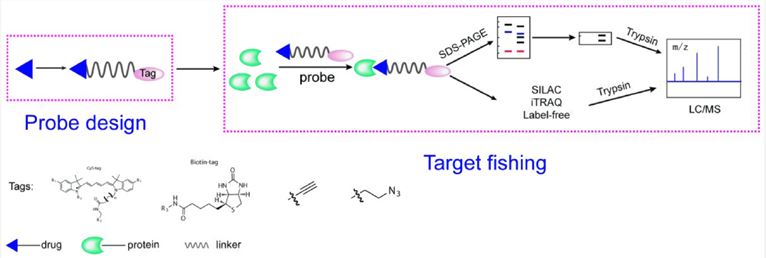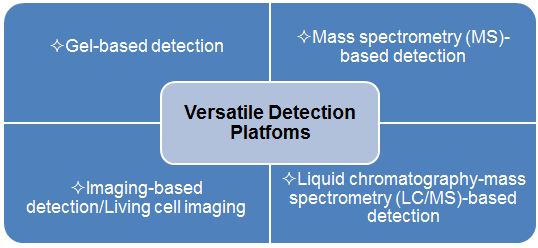Activity based Protein Profiling (Abpp)
Drug targets and mechanisms of action are still two of the biggest challenges in drug development. To address these issues, Creative Biolabs pays attention to a growing number of chemical proteomics approaches and has introduced activity-based protein profiling (Abpp) to profile targets in complex proteomes. The approach is capable of identifying the protein target of small molecules, even the active sites of the protein, and has been applied in many fields, such as:
- Protease enzymology
- Drug discovery and development
- Profiling proteases in disease
- Inhibitor discovery
In the last two decades, Abpp has emerged as a functional proteomic technology using small-molecule chemical probes to decipher the mechanism of interactions between compounds and targets. Notably, our scientists and technicians have established an overall workflow of Abpp technology and provide advanced strategies for drug discovery and target identification.
 Fig. 1 A general representation of the Abpp workflow.1
Fig. 1 A general representation of the Abpp workflow.1
How does Abpp work?
Abpp is a powerful chemical proteomic strategy for broad profiling of functional states of the protein in native biological systems. It takes advantage of active-site-directed chemical probes, named activity-based probes (ABPs), to enable visualization of the active form of proteins. ABPs are mechanism-based irreversible inhibitors, composed of an active warhead that reacts with components of the active site, a binding group that confers spacing between the active warhead and the reporter. They’re also modulating the reactivity and specificity of the probe and the reporter tag for identification and purification purposes. The active warhead is typically an electrophile and is retained on-site due to the formation of a covalent bond. Only catalytically competent proteins undergo this reaction, thereby active isoforms can be visualized in this way.
Abpp Measurement Services at Creative Biolabs
Abpp is a powerful complimentary approach to identify the binding of small molecule probes with proteins. At Creative Biolabs, we offer sophisticated Abpp services to monitor the activity of proteins and confirm direct interaction. Our strategies combine ABPs and proteomics technologies to help clients better understand the properties of compounds and the modes of action. Herein, we’re listing some basic design strategies for small-molecule probes and describe how these probes identify targets and validate the interaction of small molecules with targets. Our popular services have multiple aspects including but not limited to:
-
Abpp Strategies
Basic Strategies:
- Click chemistry-Abpp (CC-Abpp)
- Competitive-Abpp
-
ABPs Design for Proteases
- Reactive functional groups - used to bind the active site of a specific enzyme via a covalent interaction. There’re two general classes: photoreactive groups that label proximal residues in enzyme active sites following UV irradiation, and electrophilic groups that modify conserved active-site nucleophiles.
- Recognition sequence design - used to help the probe target a particular type of enzymes, or even particular enzymes within the type. There’re several serine hydrolases, such as proteases, esterases, and phospholipases, and clients can choose a general serine hydrolase ABP to analyze all of this superfamily. Alternatively, a protease-targeted probe can be used to profile just the protease subfamily.
- Reporter tags - used to facilitate target characterization. We have reporter tags including biotin, fluorophores, and latent analytical handles (e.g. alkynes or azides), which dictate experimental options for downstream analysis in Abpp.
-
Abpp Detection Techniques
Abpp is a potent technique for exploring a diversity of biological questions with great flexibility in detection methods. We’d like to provide a few sensitive detection platforms for clients to use Abpp.

Advantages
- Multiple strategic planning for characterizing dynamic changes in complex samples
- Directly monitor the availability of the enzyme’s active sites
- A comprehensive workflow covering from probe design to detection techniques
- A written report containing details of samples, protocols, and analytical data
Abpp provides a means for which novel, clinically relevant drug targets or biomarkers may be identified by gaining insight into biological processes. As a reliable supplier in target identification services, Creative Biolabs employs Abpp profiling to enable assessments of dynamic changes in proteome abundances, modifications, intracellular locations, and functional states. If you have interest in any services, please don’t hesitate to contact us.
Reference
- Wang, S.; et al. Advanced activity-based protein profiling application strategies for drug development. Front Pharmacol. 2018, 9: 353. Distributed under Open Access license CC BY 4.0, without modification.
For Research Use Only.
